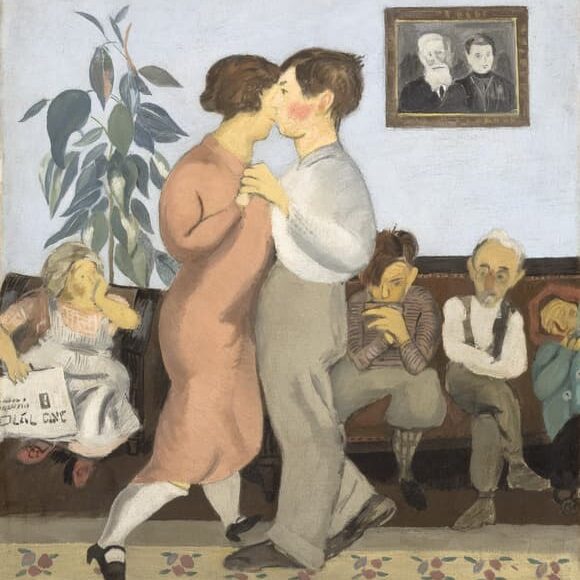Frederick Kiesler: Vision Machines

Frederick Kiesler: Vision Machines
April 25 – July 28, 2024
New York, NY, February 27, 2024—The Jewish Museum will present Frederick Kiesler: Vision Machines, concise yet rich examination of Frederick John Kiesler’s (1890-1965) experimental design practice through the activities of his Laboratory for Design Correlation at Columbia University from the late 1930s to the early 1940s. The output of Kiesler’s Laboratory included research, design studies, and drawings that probed the possibilities of his theory of biotechnique, while reflecting on the relation between, design, energy, and the human body (it’s posture, respiration rates, and image consciousness). The exhibition will highlight two of Kiesler’s most essential and ambitious projects developed at the Laboratory: the Mobile Home Library and the Vision Machine. Together these projects illustrate the fantastical scope and applications of Kiesler’s Correalism: a design approach he conceived to “express the dynamics of continual interaction between man and his natural and technological environments.” The exhibition will be on view from April 25 through July 28, 2024.
For the first time ever, Kiesler’s important but previously unrealized Mobile Home Library will be fabricated and presented in its entirety. This dynamic device proposed to improve basic domestic activities, while also radically altering domestic space. In its most iconic form, the library appears as a circular series of bookshelves; the entire piece is ambulatory, with each module also designed to spin within the Library’s ring frame. The exhibition will also include Kiesler’s drawings and studies for his Vision Machine, an ambitious device intended to visualize human sight—from optics and nerve stimuli to dream content and dream images. The selection of more than 100 drawings, photographs, and research studies of these projects will illuminate Kiesler’s remarkable attempts to grasp human vision, record dreams, and to correlate libraries, information, images, and consciousness.
Frederick John Kiesler was born into a Jewish family in present-day Ukraine in 1890. He first studied printmaking and painting at the Academy of Fine Arts but would later gain a venerable reputation as an inventive and dynamic theater set designer. In 1923, Kiesler joined de Stijl on the invitation of Theo van Doesburg, making him the group’s youngest member. After immigrating to the United States and settling in New York City in 1926, among other projects, Kiesler designed store windows for Saks Fifth Avenue, the Guild Cinema, and Peggy Guggenheim’s Art of This Century Gallery. He was also appointed as the director of scenic design at the Juilliard School of Music as well as director of his laboratory at Columbia University’s School of Architecture. Kiesler’s experiments with Correalism, biotechnique, enveloping space, Magic Architecture, human perception, and energy, underscore the rich multiplicity of his architectural vision.
In contrast to other European émigrés who reshaped American architecture by introducing European modernist building to America, Kiesler is perhaps best known for not building—a reputation affirmed by the American architect Philip Johnson with his 1960 assertion that Kiesler was the “greatest non-building architect of our time.” Kiesler did of course build, most notably exhibition spaces and the Shrine of the Book in Jerusalem. Yet he did not normalize his experimental work by positioning it as preparatory studies for future buildings; his myriad non-building projects were emphatically architectural experiments and architectural declarations.
Frederick Kiesler: Vision Machines is organized by guest curator Mark Wasiuta and developed with cooperation from the Austrian Frederick and Lillian Kiesler Private Foundation. The exhibition is designed by Mark Wasiuta, Farah Alkhoury, and Tigran Kostandyan. Fabricated by Powerhouse Arts Makers.
Programs
Programs in conjunction with Frederick Kiesler: Vision Machines include a series of lectures and virtual classes inspired by the exhibition.
Support
Frederick Kiesler: Vision Machines is made possible by Mergentime Family Archive, Stéphane Samuel and Robert M. Rubin, the Estate of Gaby and Curtis Hereld, and other generous donors.
Additional support is provided by The Skirball Fund for American Jewish Life Exhibitions, Horace W. Goldsmith Exhibitions Endowment Fund, The Joan Rosenbaum Exhibitions Endowment, The Centennial Fund, and an anonymous gift in honor of Claudia Gould, Director Emerita.
The publication is made possible by The Graham Foundation for Advanced Studies in the Arts, and Elise Jaffe + Jeffrey Brown.
Press contacts
Daniela Stigh, [email protected]













